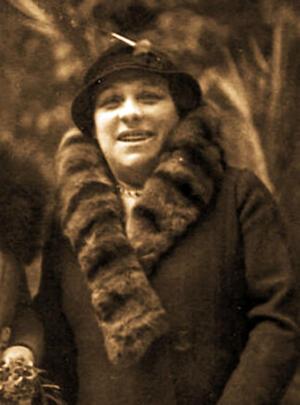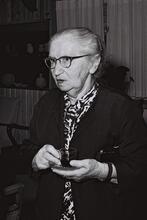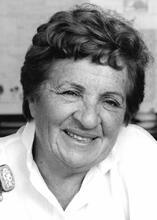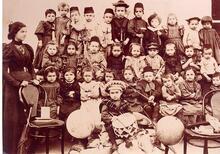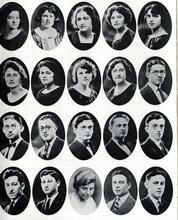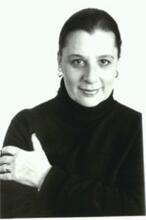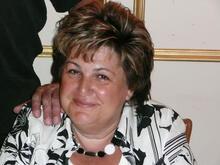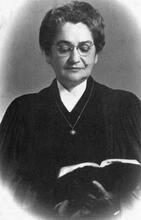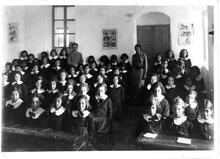Annie Edith Landau
As an educator in Jerusalem at the beginning of the twentieth century, Annie Edith Landau established new standards both in educational methods and in the cultural, ethical, and health arenas, while at the same time setting an example of polite and civilized behavior. Born in London in 1873, she was sent an Orthodox school in Germany that also valued secular education and in 1899 went to Jerusalem to teach English at the Evelina de Rothschild School for Girls. She soon became principal there and was known for preparing her students for education and civil service in the country. As an Orthodox Jew of British origin, Landau was closely connected to religious circles, the Mandatory government, and various political circles, and she used her connections to do what was best for her students.
Early Life & Education
Hannah Judith (Annie Edith) Landau was born on March 20, 1873, in London, where her father, Marcus Israel (Mordecai, 1837–1913), worked as a clerk for the Jewish community. Annie’s mother, Chaja Kohn (b. Bavaria, Germany 1853–d. 1923), was Marcus’s second wife. He had five children by his first marriage and during the forty years of his marriage to Chaja a further thirteen were born. Of these, Annie was the eldest.
Landau’s parents were of the opinion that girls should also receive a fine education, but there was no sufficiently good school for religious girls in London. Thus, at the recommendation of her mother’s uncle, Moses Weisknopf, she was sent to the Orthodox Samson Raphael Hirsch School in Frankfurt am Main, where her teacher was Mendel Hirsch (1833–1900), the son of Samson Raphael (1808–1888). At Hirsch's school, secular education was cherished along with Jewish Orthodox education.
Returning to London, Landau studied at Greystoke Teachers' Training College. After completing her studies there in 1892, she took up a teaching position at the Jews' Free School, which she held until 1898. In 1899, at the recommendation of Claude Montefiore, a governor of the school and chairman of the Anglo-Jewish Association, she was sent to Jerusalem to teach English and serve as assistant principal at the Association’s Evelina de Rothschild School for Girls. A year later she became its principal.
Arrival in Jerusalem
At the time of Landau’s arrival in Jerusalem, three European Jewish organizations were involved in the education of the Jewish community: the Alliance Israélite Universelle, the German Hilfsverein, and the Anglo-Jewish Association. The school Landau served had been founded in 1854 by the French Rothschild family; in 1868, when the English Baron Lionel de Rothschild became its patron, it was renamed after his daughter Evelina, who had died earlier. In 1892, the Anglo-Jewish Association took over the school, but the baron continued to fund it at the rate of £800 a year.
The arrival of Annie Landau in The Land of IsraelErez Israel at the end of the nineteenth century, as an emissary of British Jewry, aroused high hopes among the local community, who looked forward to assistance in the area of education, in particular. Her long residence in Jerusalem contributed greatly to strengthening the education of girls, first the daughters of the Old Yishuv Sephardi and Ashkenazi society and later, after World War I, of the many new immigrants. Landau established new standards both in educational methods and in the cultural, ethical, and health arenas, while at the same time setting an example of polite and civilized behavior.
The Evelina de Rothschild School
At the Evelina de Rothschild School, Landau sought to provide girls with both a Jewish and a general education, from kindergarten through elementary school and later also through high school. In 1900, there were 292 girls in the elementary school and 225 in the kindergarten. Immediately upon taking up her position, Landau introduced English and Hebrew as languages of instruction, in place of French, and by 1901 the school was entirely bilingual. The Ashkenazi rabbinical authorities, which opposed secular education for boys, boycotted families that sent their sons to secular schools instead of Talmud Torah and denied them monetary allocations from the Pre-Zionist era system whereby Diaspora Jews financed the Jewish communities in the holy cities of Erez Israel.halukah . Yet since girls were not obligated to study Torah, they were allowed to attend secular schools. Miss Landau, as she was always referred to, set a special example of combining orthodoxy, secular education, and a profound connection to Judaism. The number of pupils at the school rose steadily, reaching five hundred and seventy-five in 1913; many candidates had to be rejected solely for lack of space.
The school curriculum included all the subjects the pupils would eventually need to know when they graduated: The Bible, domestic science, languages, sewing, classical literature, singing, dancing, and art. Pupils successfully passed the British school-leaving examinations. Those who studied in the Commercial Stream became expert in shorthand, typing, accounting, and bookkeeping. Much sought after by employers, they later became the backbone of the administration in Mandatory government offices and at the Hebrew University. The school also operated a sewing center that provided those who worked there with an income. Over half of the pupils received a free meal every day.
The school Landau headed became known as “Miss Landau’s” and its pupils were referred to as “Miss Landau’s girls.” They admired her and were proud of being her pupils, while she, for her part, saw in them a bright future for education and civil service in the country.
Miss Landau was also intent on inculcating the social graces: she insisted on clear and proper diction and the acquisition of skills such as presiding over tea parties—for which the weekly ones at her own home were famous. Her home was a focal point of social life in the city and she hosted numerous lavish parties and receptions, such as one for Sir Ronald Storrs, the first Mandatory governor of Jerusalem, on his arrival in the city. Among the dignitaries who visited the school were Sir Herbert Samuel (1870–1963), the first High Commissioner; Rabbi Isaac Halevy Herzog, then Chief Rabbi of Ireland who in 1936 became the Chief Ashkenazi Rabbi of Mandatory Palestine (1888–1959); the Chief Rabbi of the United Kingdom, Dr. Joseph Hertz (1872–1946) and his wife; and Lord Herbert Charles Onslow Plumer (1867–1932), Samuel’s successor as High Commissioner.
Landau’s excellent relations with the Ottoman authorities led to the school’s exemption from taxes or customs duty. As a member of the Red Cross during World War I, she collaborated with Dr. Moshe Wallach (1866–1957), the head of the Sha’arei Zedek Hospital, in organizing a hospital for victims of cholera in a mission building in the Kerem Avraham quarter, and helped run the institution. She also invested effort in easing the measures imposed by Jemal Pasha, but in 1915 she was exiled as a British citizen to Alexandria, where she opened a school for the daughters of the émigrés.
In February 1918 a special permit from General Edmund Allenby enabled Landau to return to Jerusalem. Her friend Sir Eli Kadouri provided her with a huge sum of money to purchase ten tons of food and clothing for the families of her pupils, who, like most of the Jewish population of Jerusalem, were suffering from starvation.
Ideological Leanings
Annie Landau was foremost a British citizen. She did not identify with the Zionist aspiration of establishing an independent Jewish society in Palestine, and she was on close terms with British officials in the country. As a member of Jerusalem’s educated elite, she had a considerable influence on the city’s cultural and social life. As an Orthodox Jew of British origin, she was able to establish contacts not only with the Mandatory officials but also with the Mufti of Jerusalem. Herself profoundly charitable, she was successful in eliciting charity from others.
Landau was also close to the non-Zionist Agudat Israel circles and with Rabbi Hayyim Sonnenfeld, a well-known An ultra-Orthodox Jewharedi rabbi, and Dr. Moshe Wallach, head of Sharei Zedek hospital, because of her own orthodoxy. This rare combination of broad education, culture, religious observance and the unusual link between Samson Raphael Hirsch and Claude Montefiore, a prominent English Jew, was a very helpful one in the socially divided climate of Jerusalem at the time. Independent and courageous, she was a model of a woman’s ability to advance her own interests and those of the institutions with which she was involved.
In 1904 Landau was appointed an M.B.E. (Member of the Most Excellent Order British Empire), and on the occasion of the silver jubilee of King George V in 1935 she was awarded a silver medal for her fruitful work in education. On her sixtieth birthday her pupils mounted an impressive celebration that included a performance of A Midsummer Night’s Dream, a concert of orchestral and choral music, ballet and folk dances.
Annie Landau never retired. She died on January 23, 1945, and was buried on the Mount of Olives. Still remembered with great affection and admiration by those of her former pupils who have survived, she has become part of the “legend of Jerusalem.”
Hyamson, Albert Montefiore. The British Consulate in Jerusalem in Relation to the Jews of Palestine: 1833–1914. London: E. Goldston, Ltd, 1941.
Sacks, Oliver. Uncle Tungsten: Memories of a Chemical Boyhood. New York: Vintage Books, 2001.
Storrs, Ronald. Orientations. London: Readers Union, 1939.
Schor, Laura, S. The Best School in Jerusalem: Annie Landau's School for Girls 1900 – 1960. Waltham, MA: Brandeis University Press, 2013.
Shilo, Margalit. “A Cross-Cultural Message: The Case of Evelina de Rothschild.” In Jewish Women in Pre state Israel. Edited by Ruth Kar, Margalit Shilo, and Galit Chazan-Rokem, 167-179. Waltham, MA: Brandeis University Press, 2008.
Shilo Margalit, Princess or Prisoner? Jewish Women in Jerusalem 1840 – 1914. Waltham, MA: Brandeis University Press, 2005.

